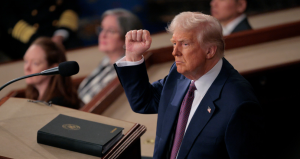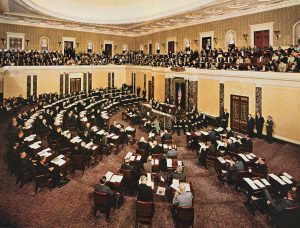On Monday, two separate federal rulings delivered significant blows to landmark policies of the outgoing Biden administration. In Texas, U.S. District Judge Matthew Kacsmaryk vacated the Centers for Medicare & Medicaid Services’ (CMS) proposed minimum staffing requirements for nursing homes—the first federal mandate of its kind. Meanwhile, the U.S. Supreme Court granted former President Donald Trump’s emergency request to lift a lower court injunction blocking the administration’s use of the 1798 Alien Enemies Act to deport certain Venezuelan nationals, including alleged members of the Tren de Aragua gang.
Collectively, these decisions underscore the complex interplay between executive authority, regulatory reach, and judicial oversight. Nursing home operators and conservative policymakers hailed the rulings as victories for the rule of law and federalism, while labor unions, elder-care advocates, and immigration-rights groups decried the setbacks as threats to vulnerable populations and longstanding legal protections.
In this in-depth analysis, we examine:
-
The CMS Staffing Rule: Origins, provisions, and objectives of the Biden administration’s first federal nursing home staffing minimums
-
Litigation and Judge Kacsmaryk’s Ruling: Legal arguments, statutory authority, and the rationale for vacating the rule
-
Implications for Long-Term Care: Workforce challenges, quality-of-care considerations, and the future of federal oversight
-
The Alien Enemies Act Decision: Historical background, case chronology, and the Supreme Court’s 5–4 order lifting the injunction
-
Legal and Policy Consequences: Executive power in immigration enforcement, checks and balances, and potential diplomatic ramifications
-
Reactions from Stakeholders: Statements from industry groups, advocacy organizations, and key policymakers
-
Looking Ahead: Prospects for regulatory reform, pending litigation, and the broader impact on public policy
Part I: Nursing Home Staffing Minimums—From Rulemaking to Reversal
1. Origins and Objectives of the CMS Staffing Rule
1.1 Long-Standing Concerns in Long-Term Care
For decades, policymakers, regulators, and patient advocates have highlighted persistent challenges in the nation’s long-term care system: inconsistent staffing levels, variable infection-control practices, and uneven quality metrics across facilities. The COVID-19 pandemic’s devastating toll on nursing home residents—who accounted for a disproportionate share of U.S. fatalities in 2020 and 2021—further exposed vulnerabilities linked to chronic understaffing and lapses in safety protocols.
1.2 CMS’s Regulatory Authority
Under the Social Security Act, CMS oversees Medicare and Medicaid certification requirements for skilled nursing facilities (SNFs) and nursing homes. The agency has routinely promulgated regulations governing patient rights, infection control, and staffing documentation. However, it had never before imposed explicit federal minimums for nurse-to-resident ratios or mandatory on-site registered-nurse presence.
1.3 Key Provisions of the Proposed Rule
On April 17, 2024, CMS published a final rule in the Federal Register that, beginning in 2026, would require every Medicare- and Medicaid-certified nursing home to:
-
Maintain at least one registered nurse (RN) on-site 24 hours a day, seven days a week.
-
Ensure that each resident receives a minimum of 0.55 hours (33 minutes) of direct RN care per day, on average.
Rural and small facilities were granted an additional 12 months—up to 2027—to achieve these thresholds. CMS projected that the rule would improve resident outcomes, reduce hospital readmissions, and strengthen infection-prevention practices.
2. Legal Challenge and Industry Opposition
2.1 Lawsuit by Nursing Home Operators
Hours after the rule’s publication, the American Health Care Association (AHCA) and the National Center for Assisted Living (NCAL)—which represent the vast majority of U.S. nursing homes—filed suit in the Northern District of Texas. Key arguments included:
-
Exceeding Statutory Authority: CMS lacked explicit congressional authorization to impose binding minimum staffing requirements.
-
Unrealistic Compliance Burden: Given the nationwide shortage of qualified RNs, many facilities would be unable to meet the proposed thresholds without drastic cost increases or closures—particularly in rural markets.
-
Inadequate Cost–Benefit Analysis: The rule’s estimated annual cost of $5.4 billion did not sufficiently weigh the risk of service disruptions or displacement of vulnerable seniors.
2.2 The Workforce Shortage Context
According to the U.S. Bureau of Labor Statistics, the healthcare sector faced a shortfall of over 200,000 RNs in 2023, driven by retirements, burnout, and uneven geographic distribution. Rural nursing homes already struggled to recruit and retain licensed nurses; some facilities reported vacancy rates exceeding 20 percent. These workforce constraints informed operator concerns that the new rule would force closures or reduce access to care during an ongoing demographic wave of aging Baby Boomers.
3. Judge Kacsmaryk’s Decision
3.1 Findings of Law and Fact
On Monday, May 6, 2025, U.S. District Judge Matthew J. Kacsmaryk—appointed by President Trump in 2019—issued a 47-page memorandum opinion vacating the CMS staffing rule in its entirety. His ruling included the following determinations:
-
Statutory Exceedance: While acknowledging CMS’s broad mandate to protect beneficiary health and safety, Kacsmaryk concluded that Congress had not delegated authority to set absolute staffing minimums. Prior staffing requirements concerned documentation, assessments, and competency verification—not quantitative ratio mandates.
-
Arbitrary and Capricious: Under the Administrative Procedure Act (APA), agencies must demonstrate a rational connection between the facts and policy choices. Kacsmaryk held that CMS failed to adequately justify why 0.55 hours per resident per day was the necessary threshold, nor did it consider alternative solutions such as targeted funding for workforce development.
-
Unrealistic Implementation: Recognizing the pandemic-era staffing crisis, the court found that CMS underestimated the rule’s disruptive potential. The projected compliance costs could “force numerous facilities—especially in underserved areas—to close, displacing residents and undermining access to care.”
3.2 Vacatur vs. Remand
Rather than remanding the rule for further consideration or revision, Judge Kacsmaryk vacated it outright, meaning the staffing requirements would have no legal effect. His opinion urged Congress to address long-term care workforce shortages through legislation rather than regulatory fiat.
4. Reactions and Ramifications
4.1 Industry and Political Responses
-
AHCA/NCAL: Clif Porter, CEO of AHCA/NCAL, praised the ruling as a “victory for the rule of law” that “protects access to care for our aging population.” He warned that forced compliance would have “closed nursing homes and displaced vulnerable seniors.”
-
Labor Unions and Advocates: The Service Employees International Union (SEIU) and the Long-Term Care Community Coalition decried the decision. SEIU President Mary Kay Henry argued that “strong federal standards are essential to ensure safe staffing and quality care for residents”—calling on the Biden administration to appeal.
-
CMS Statement: CMS issued a brief statement indicating that it was reviewing the court’s decision and considering legal options. An appeal to the Fifth Circuit Court of Appeals appears likely, setting up a protracted judicial review over the agency’s rulemaking authority.
4.2 Policy Implications
-
Presidential Transition: With a new administration set to take office in January 2025, the future of the staffing rule may hinge on the priorities of incoming leadership and the composition of Congress.
-
Workforce Solutions: Stakeholders emphasize the need for robust federal and state collaboration on nurse education grants, loan-forgiveness programs, and immigration-based pathways to attract foreign-educated nurses.
-
Regulatory Strategy: The ruling signals a judicial willingness to clamp down on expansive regulatory interpretation, potentially influencing future CMS and health-related rulemaking under any administration.
Part II: The Alien Enemies Act and the Supreme Court’s 5–4 Order
5. Historical Background of the Alien Enemies Act
5.1 Origins in 1798
The Alien Enemies Act (Title 50 U.S.C. § 21) was enacted amid the Quasi-War between the United States and France. It authorizes the President to detain, deport, or restrict movement of male nationals (aged 14 and older) of a country with which the U.S. is at war. The statute saw rare use:
-
War of 1812: Detention of British nationals.
-
World War I: Alien monitoring and internment of German nationals.
-
World War II: Internment of individuals from Axis nations, albeit mostly handled under separate executive orders.
Prior to the 2024 controversy, the Act lay dormant for over 70 years.
5.2 Reinvigorated Use in 2024
In early 2024, the Trump administration invoked the Alien Enemies Act to target Venezuelan nationals implicated in transnational criminal organizations. Specifically, the Department of Homeland Security (DHS) moved to classify members of the Tren de Aragua gang—alleged to engage in human trafficking, extortion, and violent crimes—as alien enemies subject to immediate removal without standard immigration-court proceedings.
6. Lower-Court Challenge and Stay
6.1 District Court Injunction
A coalition of civil-rights groups, including the American Civil Liberties Union (ACLU) and several immigrant-rights coalitions, sued to enjoin DHS from using the 1798 statute for summary deportations. In March 2025, U.S. District Judge Tanya S. Chutkan (D.D.C.) granted a preliminary injunction. She held that:
-
Due Process Concerns: The Act’s summary-removal provisions circumvented established immigration adjudication processes, violating constitutional and statutory due process guarantees.
-
Statutory Interpretation: Congress did not intend the Alien Enemies Act to replace the Immigration and Nationality Act’s removal framework for noncitizens on U.S. soil.
DHS subsequently paused enforcement against several dozen designated individuals, pending further judicial review.









